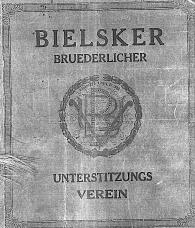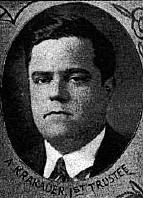
In 1928, the organization held a gala event to celebrate the 40th anniversary of its founding. The "40th Anniversary Souvenir Journal" distributed at that event is available on the Internet - click that link to open an index (in a new window). Since English is a Germanic language that is very closely related to German, it's not surprising to see the name of the organization written out in ordinary "Roman" characters. But would Yiddish speaking Russian Jews have ever written it this way? Of course not, the Roman alphabet is not used at all in Russia. But all Jews of that era (and for that matter, many modern Jews) learn to read Hebrew, in order to read the Old Testament and other books in their original languages (Hebrew and Aramaic). Thus the phonetic Hebrew alphabet was the logical alphabet for them to use to transcribe Yiddish. If you peruse the "Souvenir Journal", you'll notice that pages 11 through 15 are written in Hebrew characters. This is not Hebrew, but rather Yiddish, for the benefit of members of the Association who might have been more comfortable with Yiddish than English. There would have been no reason to include Polish. It's possible that some of the members didn't speak Polish at all. I was a little surprised by how much Yiddish there was in a journal for an event in 1928, 40 years after the Association was founded. Wouldn't the association members all be comfortable in English by then? But then again, new people could have been arriving all along, and some of the members might have been more comfortable in Yiddish. As a language buff, I used some clues from this journal to learn a bit about Yiddish, a language that I don't speak. I have a lot of fun thinking about things like this. You may think I'm nuts. The top of page 14 includes the name of the Bielsker Bruderlicher Unterstitzungs Verein written in Yiddish, although it's spread over two lines. Here it is: The Hebrew alphabet has a particular problem. Its characters are mostly consonants, and the vowels are added by small vowel marks placed under the characters. These vowel marks are generally omitted in writing. The reader has to be able to recognize the word from the consonants alone. Hr's wht nglsh lks lk f y d tht. Some tricks are apparently used in the transcription of Yiddish to get around this problem. Look at the above text, and compare it with the version in Roman characters. Remember that while you read the Roman version from left to right, you have to read the Yiddish version from right to left, because that's the way Hebrew is read. I've marked it up with the approximate phonetic value of each Hebrew character underneath: In the above, I've used "H" to represent the guttural "CH" sound (the sound in the German "ach"), and "Z" to represent the "ts" sound. Sorry the image is a bit tilted - it was like that on the page as it was scanned. Note 1 It seems clear from the above that the Hebrew letter
Note that in the third line of the poem, Abe rhymed "VEREIN" with "main", and in the last line, he rhymed it with "remain". In German, "VEREIN" is pronounced "fe-RINE", to rhyme with "mine". From my grandfather's rhyme, I surmised that in Yiddish the word "VEREIN" is pronounced "fe-RAIN", and indeed does rhyme with "main" and "remain". I asked my uncle Bill Krakauer about this, since he's one of the few family members who can still speak Yiddish. He replied with a short lesson in Yiddish orthography, writing, "I have heard 'Verein' pronounced both ways, like the German or rhyming with 'rain'. Yiddish can be very flexible, the pronunciation varying a great deal in different parts of Europe and with different levels of education and sophistication. Of course Hebrew has vowels, but they are in the form of marks under the letters. They are sometimes used, irregularly as far as I can tell, in written Yiddish as well, sometimes as the little horizontal bar under the aleph. Usually however the vowel sounds in Yiddish are indicated by the letter aleph itself ( Bill, a retired psychiatrist, has created a second career as an actor and singer. Among other credits, he's performed in a Yiddish stage production. I love puzzling out these sorts of deductions about a language that I don't know. However, I'm sure I will never duplicate the feat of Jerry Holland, who once picked up a book at the book exchange station of our town's sanitary landfill and recycling center. Although it was written in an entirely unknown language, that didn't stop him from taking it home and successfully reading it. I'll describe this more in a future blog entry. The pronunciation of Yiddish differs from that of German in a number of ways. The German word for "Jew" is "Jude". In the adjectivial form, "jewish", the u picks up an umlaut, and the word becomes "jüdisch". The umlaut also changes the pronunciation of the u, making it a "front rounded vowel", a sound that English doesn't have at all. To me, it sounds very much like the "u" of French. In making the transition to Yiddish, that German sound very often (but not always) turns into the sound of a short "i". Thus "jüdisch" in German became "yiddish" in Yiddish. Even without the umlaut, "Jude" in German apparently became "yid", which simply means "Jew" in the Yiddish language. Thus just as a "Pole" (from Poland) speaks "Pol-ish, a "yid" speaks "Yid-ish". Note 2 The transformation of the ü into a short i is also what changed "gefülte" in German into "gefilte" in Yiddish (as in "gefilte fish). "Gefülte" is a German past participle meaning "stuffed". In the original versions of gefilte fish, the chopped fish was often stuffed back into the skin and rolled up. Note 3 It seems that back in 1924, Yiddish speakers called their own language "Yiddish" only when speaking Yiddish, but called the language "Jewish" when speaking English. I say this because of what I observe in a different Souvenir Journal, that of the 20th Anniversary Banquet of the Loan Fund in 1924. In that Souvenir Journal (only a portion of which is reproduced below), two recitations by a Mr. Giberman are listed as being "In Jewish":  In a bit of internet research, I was startled to find that in English, the word "yid" is considered by some to be a derogatory term for a Jew. But it's exactly what Jews call themselves in Yiddish. I have a couple of other stories about Yiddish. A college friend of my father's took a German course while he and my father were both students at Cornell University (my father was a student there from 1931 through 1935). At home, the friend spoke Yiddish with his parents and his grandparents, which gave him a substantial advantage over the other students in the German course. Yiddish and German are so alike that many sentences are mutually comprehensible. The student thought it possible that the professor, from Germany, might be anti-Semitic. I don't know if he had any reason for believing this, but he never mentioned his Yiddish-speaking background to the professor. And indeed, every time he spoke in class, the professor seemed to look at him strangely. Finally, after he spoke one day, the professor gazed at him for a moment, and then said, "Herr Schwartz, I can't figure out where you got your South German accent." In her youth, my aunt Barbara (Bill's wife) was once touring Germany with a group of students. Sitting in some railroad station, one of the group asked when their train was leaving, and Barbara answered, "At two o'clock". Someone asked, "How do you know that?" Barbara replied, "They just announced it." The other said, "But the announcement we just heard was in German, and you don't speak German." Ah, but Barbara had been exposed in her youth to Yiddish. She had taken in the meaning of the announcement without even thinking about it. [return to text]
  Note 1: The image of the BBUV's name written in Hebrew characters was taken from Page 14 of the Souvenir Journal, where it appears on the first and second lines (I combined the images onto a single line). That page of the journal seems to have been a bit tilted in the scanner. Allow me to repeat some of the links I mentioned in my previous entry. All the links in this note take you off my page, so you might want to come back and explore them later, or open them in a separate window. A good deal is known about Bielsk and the BBUV because a great deal of information has been preserved on the web by JewishGen, an affiliate of the Museum of Jewish Heritage. They have a page called "JewishGen KehilaLinks" (formerly "ShtetLinks"), a project "facilitating web pages commemorating the places where Jews have lived." From there, one can click to "Poland", and then to "Bielsk-Podlaski", for information on the town and its Jewish population in the past. Then one of the links (under the heading "Source Materials") takes you to the "Bielsker Bruderlicher Unterstitzungs Verein" ("BBUV"). And one of the links on the BBUV page is to the 1928 "Complete 40th Anniversary Banquet Souvenir Journal". [return to text] Note 2: My thanks to Frank Model, who learned German as a child, for helping me sort this out. My German has gotten pretty rusty. [return to text] Note 3: Not all u-umlauts become "i" sounds in Yiddish. The ü in "brüderliche" has been preserved as a ü sound, for instance. This accounts for the two different spellings of the word in the various sources I've referenced. The JewishGen KehilaLinks site simply dropped the umlaut on its web pages, so they spell the word "bruderliche". But in the 40th anniversary Souvenir Journal of 1928 (see the image of the cover at the top of this entry), the ü is represented by the characters "ue", so the word is spelled "bruederliche". This was a standard way of representing a ü when using a typewriter that didn't have accented characters. However, in my grandfather's ode to the BBUV, within the program, he omitted both the umlaut and the "e", representing the sound simply with the ordinary letter "u". [return to text]
 |
 In my last blog entry, entitled "
In my last blog entry, entitled " I also got a clue about the pronunciation of Yiddish from a poem my grandfather
I also got a clue about the pronunciation of Yiddish from a poem my grandfather